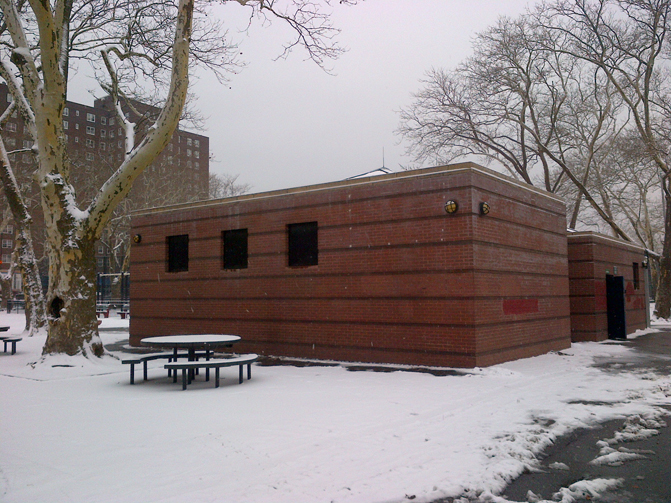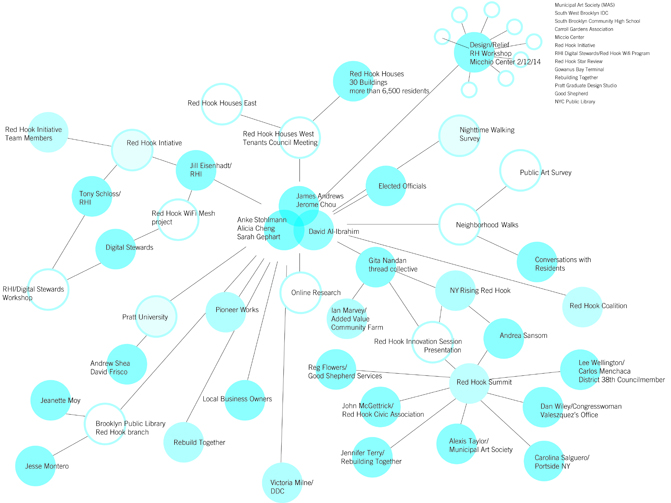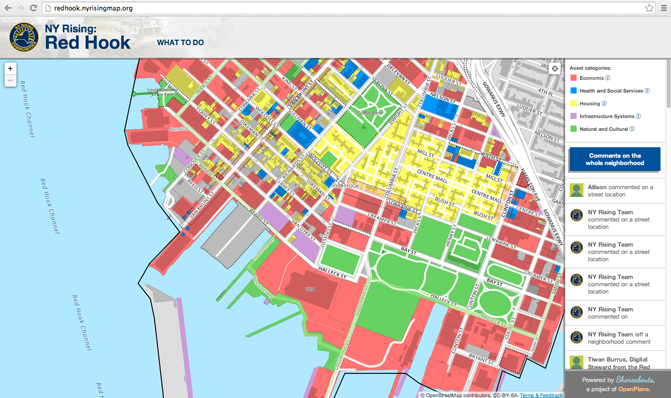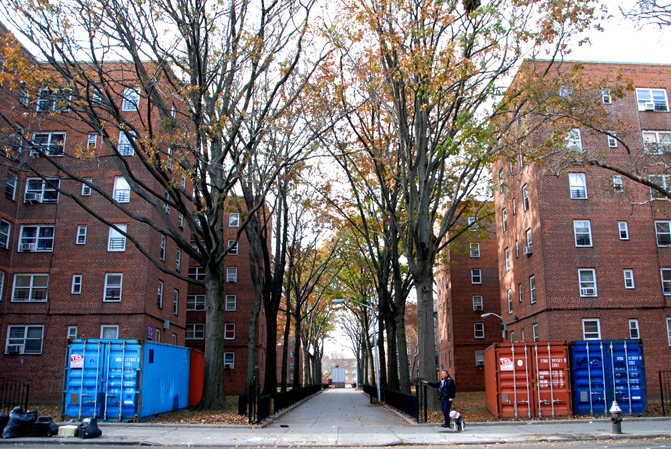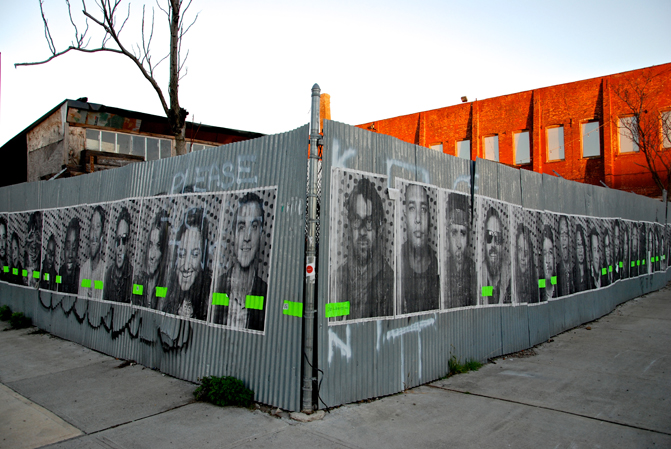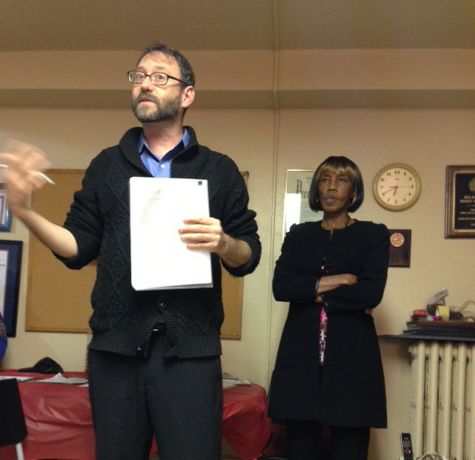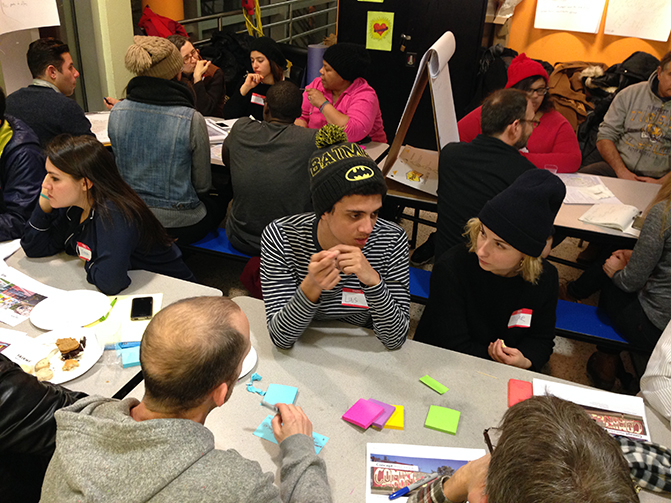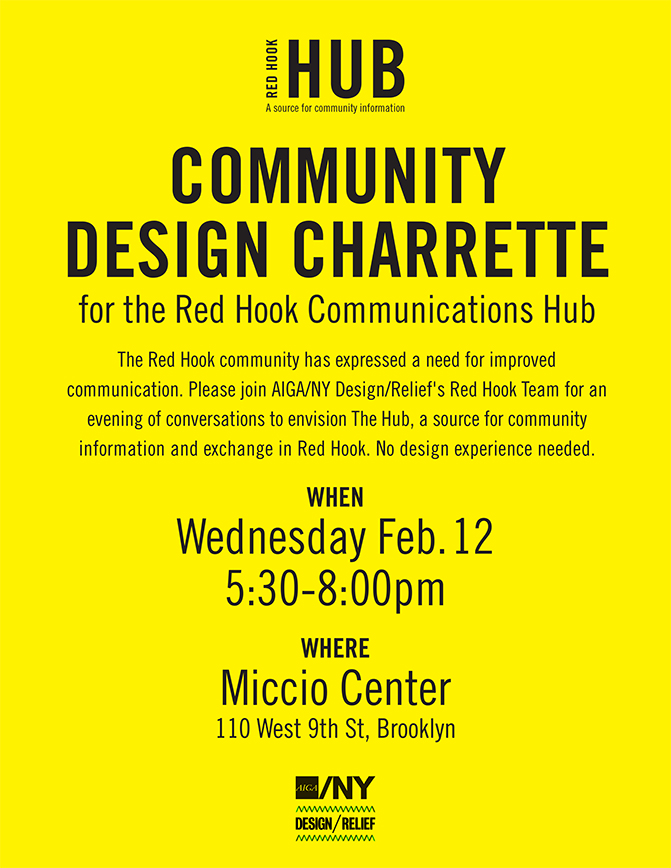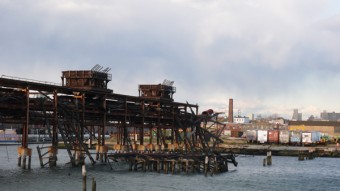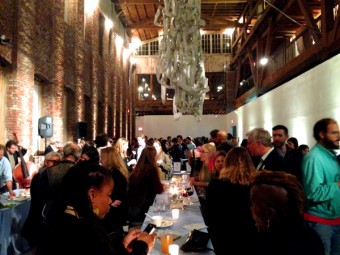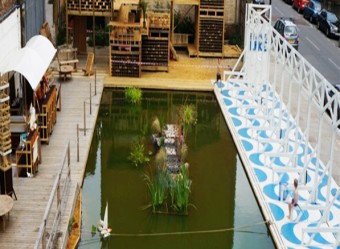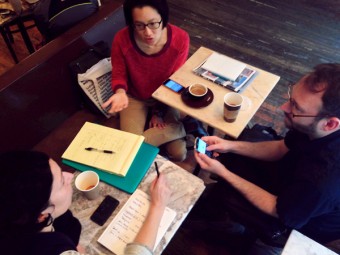Design/Relief
Red Hook
RED HOOK TEAM
Designers Anke Stohlman, Lil’Robin, principal
with Alicia Cheng and Sarah Gephart, mgmt., principals
Community Outreach Strategist
James Andrews, Amplifier Project
Storyteller
David Al-Ibrahim, communication designer and writer
Wednesday 26 February 2014
Red Hook Sites for HUB
Looking at various outdoor places in Red Hook, such as Coffee Park, a central meeting point, in the summer, more than the winter
Red Hook Community Engagement Strategy
The Red Hook team has mapped out, in an ever-growing diagram, the intertwined network of local community organizations, key-players, activists and institutions
Red Hook Neighborhood Exploration
Red Hook Team discovery phase, November-December 2013
Our Red Hook team has been busy on the ground conducting research, mapping out the front and back of Red Hook, interviewing stakeholders and residents, represented by a diverse palette of organizations such as tenant associations, social and health services providers, and recovery efforts entities, to name a few. They made a point in “plugging in” existing community meetings, rather than creating their own. Their approach has been driven by a humble effort in listening and approaching these communities as outsiders and blank slates, at a time when a number of organizations, Federal, State and otherwise, have poured into these places to offer solutions for stronger, more resilient and sustainable places. Although our teams were warned of the general fatigue that the Red Hook community may feel, they have only found open hearts and hands.
NY Rising, Gov. Cuomo state-funded initiative, has been an inspiration for our team, whose members attended a number of their Red Hook-based community gatherings. Their website includes interactive maps of Red Hook, and other Disaster-stricken areas in which they’ve been working to identify community needs since this fall.
The Red Hook Houses and the JR project near the NYCHA Houses. Photo: David Al-Ibrahim
Red Hook team storyteller James Andrews presenting Design/Relief at the Wednesday meetings of the Red Hook Houses, November 18, 2013
Wednesday 12 February 2014
Community Workshop in Redhook @ Miccio Center
Monday 11 November 2013
Kicking off in Red Hook
ANNIVERSARY LAUNCHING PAD, OCTOBER 2013
AIGA’s Design/Relief initiative has officially launched, and in Red Hook, community cohesion is especially palpable in light of Sandy’s one-year anniversary. Though, Red Hook is a neighborhood of many communities experiencing change, commercialization and a great deal of outsider attention, there is a sense of commitment to community that appears to have strengthened since facing the storm.
Red Hook Harbor seen from the ferry. Photo: Laetitia Wolff
At the 7th annual Taste of Red Hook benefiting the Red Hook Initiative (RHI), Founder & Executive Director Jill Eisenhard poignantly noted that when Sandy struck “Red Hook did what Red Hook does” and collectively took action. The event itself reflected a-coming-together of the neighborhood’s different communities, where local chefs and entrepreneurs (new and old) showcased Red Hook’s culinary scene in support of the youths and residents advocated for by RHI.
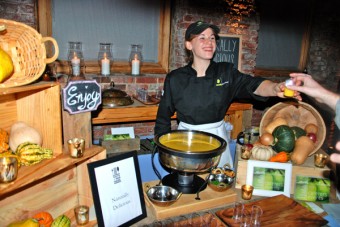
Taste of Red Hook. Photo: David Al-Ibrahim
Successful programing and RHI projects were also highlighted, such as the “wi-fi mesh network” that is being implemented by the Digital Stewards, young adults from Red Hook ages 19-24, to provide free internet access throughout Red Hook. (Of course, the food was fabulous.)
Taste of Red Hook at Pioneer Works. Photo: David Al-Ibrahim
However, Red Hook’s increasing popularity as subject of study and grant attention since Sandy has been a challenge. At Design/Relief kick-off meeting, RHI’s Jill Eisenhard explained how the influx of researchers, urban planning projects and aid programs is wearing on residents and local organizations – likening Red Hook to a Petri dish. The other Red Hook community stakeholders present expressed similar concerns, noting a sense of “fatigue” among those trying to balance engaging new projects while managing their own initiatives.
As a new project in Red Hook, as well as a new kind of community-focused design program, this notion of fatigue presents interesting challenges for Design/Relief as we explore new approaches to creative placemaking and what it means to serve a community.
Days following the Taste of Red Hook, Design/Relief hosted the Tate Modern’s Donald Hyslop to illuminate his own creative placemaking perspectives at a neighborhood “art and innovation” center called Pioneer Works. As Head of Regeneration and Community Partnerships, Hyslop is focused on the intersection of museum and city, business and people. Hyslop illuminated the importance of bringing aspects of the museum out into the community to make content more accessible, create links with residents, and provoke dialogue. Partnerships and dialogue, Hyslop emphasized, “are how you make creative places.”
The Lake, Courtesy of EXYZT Architects and Lake Estates, London
The very existence of Mr. Hyslop’s position and department at the Tate speak to the evolution of design thinking for social good and the still loosely defined concept of “creative placemaking.” The Tate Modern, now in another phase of expansion, has had a significant role in radically changing the fabric of its Bankside neighborhood, creating a type of arts district that continues to draw millions annually. Drawing parallels between Red Hook and the Bankside, Hyslop proposed that urban development, community engagement and creative placemaking should be approached through a framework as opposed to a master-plan, a model that can adapt to the communities real and often changing needs.
Red Hook team thinking at THINK. Photo: David Al-Ibrahim
As for team Red Hook, we are in the process of identifying key stakeholders and potential partners, while working to develop efficient workshops that minimize fatigue and highlight areas where the neighborhood’s different communities intersect.
Tuesday 5 November 2013
DESIGN/RELIEF: OCTOBER PRESS RELEASE

Contact: Laetitia Wolff
Program Director
(212) 710-3156
email hidden; JavaScript is required
AIGA/NY Announces Final Selection of Design/Relief TeamsDesign/Relief teams begin collaborations in Red Hook, the Rockaways and South Street Seaport on the one-year anniversary of Hurricane Sandy as part of AIGA/NY’s efforts to inspire communities through graphic design
For immediate release: New York, October 28, 2013: AIGA/NY announces final selection of Design/Relief teams. Design/Relief is a participatory design initiative that aims to support three New York City neighborhoods – Red Hook, the Rockaways and South Street Seaport – imagine a more vibrant future for themselves as they overcome the lingering effects of Superstorm Sandy. This special project of the New York chapter of AIGA explores design’s potential in defining and expanding creative placemaking to positively transform communities. Design/Relief is supported by an innovation grant from ArtPlace America.
This designer-led initiative will establish collaborations with various partners-stakeholders, who can reflect the diversity of interests in a given community, but not necessarily with one single client in mind. Each Design/Relief team will work collaboratively with their respective sites (Red Hook, Rockaways and South Street Seaport) to develop an implementable design concept that addresses livability, legibility, navigability and vibrancy.
Each team includes one to two graphic designers tasked to identify an opportunity and a way to materialize a meaningful, neighborhood-specific design project, supported by one or two community engagement strategists who will focus on outreach and participation, along with one or two storytellers who will visually document the design process and create visibility for the project through regular blog reports. Each team will work with the community to leverage existing assets and efforts while they contribute to creative placemaking definitions and build a case study to inspire other AIGA chapters across the country to take on similar design-led initiatives.
COMPLETE LIST OF DESIGN/RELIEF TEAM MEMBERS
AIGA/NY Executive Board: Willy Wong, Glen Cummings and Manuel Miranda
AIGA/NY Design/Relief Program Director: Laetitia Wolff
RED HOOK TEAM
Designers Anke Stohlman, Lil’Robin, principal with Alicia Cheng and Sarah Gephart, mgmt., principals
Community Outreach Strategists
Amplifier Project (Jerome Chou, James Andrews and Stephen Zacks)
Storyteller
David Al-Ibrahim, communication designer and writer
ROCKAWAY TEAM
Designers Natasha Chandani and Danielle Aubert, Placement Publication, founders
Community Outreach Strategist Daniel Latorre, The Wise City, founder
Storytellers Carolyn Louth, art director with Rich Tu, illustrator
SOUTH STREET SEAPORT TEAM
Designer Yeju Choi, NowHere Office, Creative Director
Community Outreach Strategists
Francesca Birks and Josh Treuhaft/ARUP
Storytellers Cristian Fleming and Stephanie Lukito, Public Society, infographics designers
“This curated group really fits the profile of participants we were aiming to recruit, i.e. skilled mediators, resourceful thinkers and makers, eager to collaborate and bring their design-focused vision to help reinvigorate a sense of identity in these waterfront neighborhoods still hit hard as we approach the one-year anniversary of Sandy,” says Laetitia Wolff, program director of the initiative. The stellar cast of emerging designers features varied and complementary backgrounds in editorial design, interactive design, digital strategy, art direction, photography and illustration, as well as activists familiar with community engagement.
The Design/Relief teams were introduced at a recent kick-off event, which included a presentation of the program’s framework, goals, team structure and collaborative approach. A selection of community representatives from the three neighborhoods also shared their experience and perspectives, providing inspiring, informative and touching testimonies. Stakeholders ranged from NYC Small Business Services grant managers focused on cohesion in the South Street Seaport merchants community, photographers documenting the effects of Sandy on low-income residents and independent business owners of the Rockaways to social services and community activists in Red Hook. The presence of these community leaders marked the first step towards establishing a partnership with neighborhood associations and nonprofits, small businesses, Business Improvements Districts (BID), and individuals who have a vested interest in rebuilding efforts in these neighborhoods.
“Design/Relief hopes to foster a sense of camaraderie among its participating members, and encourage discussion around graphic design’s creative process and capacity for social and cultural impact, while modeling methods of engagement and eventually setting standards of best practices in the field of community-centered design,” says Willy Wong, President of AIGA/NY.
As part of the Design/Relief ecosystem, AIGA/NY will develop a series of public programs to create interactive moments for both the selected team members and the design community at large, while expanding the conversation around creative placemaking in each of the neighborhoods. AIGA/NY was proud to invite inspiring leaders in community development such as UK-based expert Donald Hyslop, Head of Regeneration and Community Partnerships at Tate Modern, London. “I really enjoyed my visit to Red Hook. As the area rebuilds I hope there will be many opportunities for creative projects, both temporary and permanent, to be developed in partnership with and for local people. Design/Relief has a vital role to play in this work and I look forward to keeping in touch with the project,” says Hyslop.
For complete biographies of the team members, visit here
If you are interested in receiving dedicated emails regarding DESIGN/RELIEF please update your email preferences here.
About AIGA/NY
AIGA/NY is the largest chapter of AIGA, the nonprofit professional association for design. Founded in 1914 and headquartered in New York City, AIGA has brought design to the world, and the world to designers. The New York Chapter aligns with AIGA’s overall mission to advance design as a respected craft, strategic advantage and vital cultural force. From content that defines the global practice to events that connect and catalyze, AIGA/NY works to enhance the value and deepen the impact of design on business, society and our collective future. Learn more: 2006.aigany.org and follow us on Twitter at @aigany.
About ArtPlace America
ArtPlace America provides grants and loans, supports research, and conducts outreach and advocacy. To date, ArtPlace America has awarded 134 grants totaling $42.1 million to 124 organizations in 79 U.S. communities (and a statewide project in the state of Connecticut). Foundations participating in ArtPlace America include Bloomberg Philanthropies, The Ford Foundation, The James Irvine Foundation, The John S. and James L. Knight Foundation, The Kresge Foundation, The McKnight Foundation, The Andrew W. Mellon Foundation, The William Penn Foundation, The Rockefeller Foundation, Rasmuson Foundation, The Surdna Foundation, and two anonymous donors. ArtPlace America also seeks advice and counsel from close working relationships with various federal agencies, including the National Endowment for the Arts, the departments of Housing and Urban Development, Health and Human Services, Agriculture, Education, and Transportation, along with leadership from the White House Office of Management and Budget and the Domestic Policy Council. ArtPlace America is also supported by a $12 million loan fund capitalized by six major financial institutions and managed by the Nonprofit Finance Fund. Participating institutions are Bank of America, Citi, Deutsche Bank, Chase, MetLife, and Morgan Stanley.
DESIGN/RELIEF INITIATIVE IS FUNDED BY:
